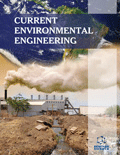Abstract
In this research, the removal of methylparathion from aqueous solutions using ozonation process was assessed. Therefore, the response surface methodology and central composite design (CCD) of experiments were performed to evaluate the effects of individual operating variables and their interactions on the methylparathion (MP) removal with initial concentration of 1000 mg/L as fixed input parameter and the extent of MP degradation as responses. The effects of variables pH and reaction time were studied. Analysis of variance showed a high coefficient of determination value in the range of 0.9. The maximum degradation of methylparathion terms of MP removal (Y1), chemical oxygen demand (COD) removal (Y2) and total organic carbon (TOC) removal (Y3) were found to be 97 %, 92.4 % and 72 % respectively. p-nitrophenol and 3-methyl-2-(2-oxopropyl) furan were noted intermediates during the degradation. It was observed that optimum degradation of methylparathion can be successfully predicted statistically by CCD using ozonation.
Keywords: Central Composite Design (CCD), Chemical Oxygen Demand (COD), degradation, methylparathion, optimization, ozone catalyst.
Graphical Abstract
 13
13 1
1

